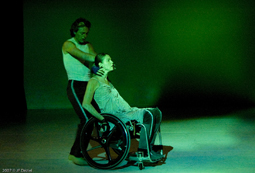Alan Lucien Øyen, choreographer and the artistic director of winter guests, is bringing his piece Story, story, die. to Harbourfront Centre later this month in a Toronto premiere. A very personal piece, it explores some of our deepest human wants and needs. “I knew I wanted to do something on all the things we do to be loved, to be liked or to be appreciated. I feel like that’s a major drive or major cause of insecurity,” he says.
Because he is “always looking for this very personal and sincere expression onstage,” Øyen decided to create Story, story, die. collaboratively with the performers. As part of his process, he assigned questions and tasks that would prompt conversations, an exchange he describes as “very fluid.”
This desire for sincerity has made him more preoccupied with content than form. As he puts it, “I often used text to create the choreography. Even if it’s completely unrecognizable, the dancer knows the meaning of each gesture or each move they do onstage. For me, [it] changes how they perform it. It’s a work born out of dialogue.”

Nathalie Bonjour, director of performing arts at Harbourfront Centre, was very moved by the piece when she saw it in Amsterdam and decided to program it for the festival. “It touches on very deep feelings of loneliness and longing for acceptance that are very real for every human being,” she says. “Alan manages to explore these ideas through the medium of dance in an emotional and visceral way; it’s beautiful.”
Øyen’s fascination with both staging and what he describes as “fictionalization,” further informs the piece, adding to its many layers. “Memories become fiction. How can they not become fiction [when] they are stories?” he asks. “[It’s] the same in present tense.… Social media is part of this but it’s always how we’ve been as humans; you dial up and down,” based on the story you want to tell about yourself. “In the end, we’re becoming television for each other and marketing channels.”
The speed of technology and social media is woven into the pace of the choreography. “There’s a lot of fast movement; there’s a lot of drive underneath the surface,” says Øyen. “It’s a kind of response to a time when I feel like everything in our lives is accelerating to such a high degree or high pace that it feels like some sort of runaway train.”

While the piece was created before the pandemic, Bonjour notes that its themes of connection, communication and loneliness have become more relevant to audiences, describing it as “more current” than when it was originally created. “Audiences can appreciate and relate to the work.… These ideas are even more interesting to explore [now],” she says.
“We speak to each other with words, but what we really read is eye movement, how fast we breathe, how our shoulders are positioned; body language is everything,” says Øyen when asked why dance is the right medium to explore the deepest of human desires. “An art form that bases itself on that codified language that we all speak so well, that we all know … it’s abstract and opens up [space] for interpretation.”
This space is crucial in his goal of connecting with humans as an artist. “Having these pockets of abstract openness inside the work that is seemingly narrative or that is narrative, that gives space for your narrative somehow … it can have the possibility of connecting more directly to more people. It opens up the work and makes it hopefully more universal.”
Story, story, die. is presented by Harbourfront Centre on June 28 and 29 as part of the contemporary dance series Torque and the yearlong Nordic Bridges initiative led by Harbourfront Centre that fosters cultural exchange between the Nordic Region and Canada.
For more information and tickets, visit https://bit.ly/3MfeK9t.
Tagged:






